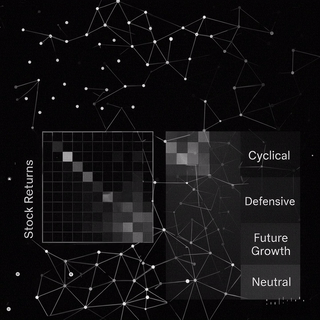
Investment Process
Assessing the investment universe

Using machine learning techniques to add structure to investment opportunities

















Our investment process is systematic, data-driven, and repeatable. It begins by organising the investable universe in a more intelligent way—one that reflects how companies actually behave in markets, not just how they are categorised on paper.
Most traditional investment strategies group companies by sectors or regions. But in practice, this can be misleading—companies in the same sector often behave very differently. That’s why Forward Lucy takes a different approach.
We start by looking at how companies move in the market. Using machine learning, we analyse the return patterns of thousands of stocks to see which ones tend to move together. Stocks that behave similarly—because they are affected by the same themes or have similar business models—are grouped into what we call clusters.
To make sure these groupings also make sense from a business perspective, we overlay detailed company data. This includes information on what each company actually does and where its revenues come from—using data from business classification systems. For example, instead of calling Amazon just a retail company, our system understands it also operates in cloud computing—and reflects that.
In the end, the investment universe is divided into small groups of similar companies that are easier to compare and more useful when building a balanced, diversified portfolio.
To help with top-down decisions, we also organise these clusters into four broader categories:
-
Cyclicals – companies that tend to do well when the economy is strong
-
Defensives – more stable companies that hold up in weaker markets
-
Future Growth – fast-growing businesses driven by long-term themes
-
Neutral – companies that don’t fit neatly into any one category
This structure is the foundation of everything we do. It allows us to analyse companies more effectively, compare like with like, and build portfolios that are both diversified and well-balanced.

Sentiment Analysis
Using AI to find value in financial news & reading the market's mood

Once we’ve grouped companies into meaningful clusters, we move to the top-down part of the process: understanding how the market is feeling.
Forward Lucy doesn't rely on economic forecasts or opinion-driven outlooks. Instead, we use sentiment analysis to measure how investors are reacting to news and events in real time. This helps us gauge what kind of market environment we’re in—optimistic, cautious, risk-seeking, defensive—and adjust our positioning accordingly.
We do this using a systematic approach to reading and interpreting language. Our model scans thousands of financial news articles, earnings transcripts, and market commentary each month. It doesn’t just count positive or negative words—it understands context and tone, distinguishing between, say, rising inflation being seen as a growth signal or a risk factor.
These signals are then translated into an overall macro sentiment score, which influences key portfolio decisions:
-
Whether to take on more or less risk
-
Which clusters to lean into or avoid
-
Which factors (like quality, momentum, or value) are best suited to the environment
Importantly, we’re not guessing how investors should feel—we’re measuring how they actually do. This allows the strategy to be more responsive to changing conditions, without relying on subjective judgement or delayed data.

